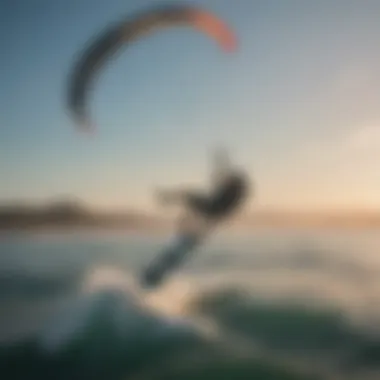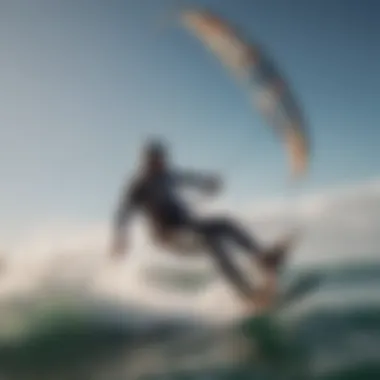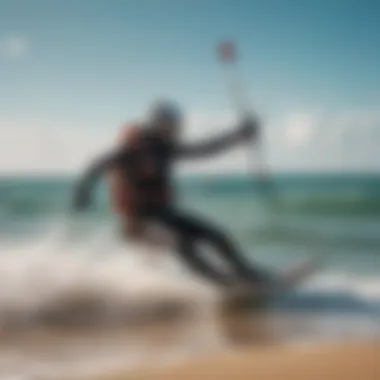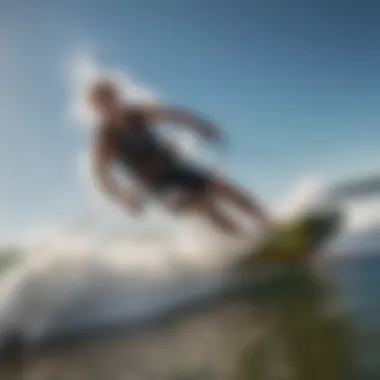Unlocking the Secrets of Kitesurfing Mastery: A Comprehensive Guide to Mastering Kitesurf Basics


Equipment Reviews
Kitesurfing enthusiasts are always on the lookout for cutting-edge equipment that enhances their performance on the waves. In this section, we delve into the realm of kite equipment, providing a comprehensive overview of the latest kite models. From analyzing various kite shapes to exploring different sizes, materials, and renowned brands, we leave no stone unturned in equipping riders with the knowledge needed to make informed decisions based on their riding style and preferences.
Kites: Shape, Size, and Materials
Kite shapes play a crucial role in determining the performance and handling characteristics of the kite, influencing aspects like stability, responsiveness, and wind range. Whether riders opt for delta, hybrid, or bow-shaped kites, each design caters to specific riding styles and skill levels. Similarly, understanding how size impacts power delivery, depower abilities, and wind range aids enthusiasts in selecting the ideal kite size that aligns with their weight, wind conditions, and riding objectives. Moreover, exploring the diverse materials used in kite construction, such as ripstop nylon, Dacron, and Kevlar, sheds light on durability, weight, and performance aspects that shape the overall kite experience.
Boards: Twintips vs. Directional
As integral components of the kitesurfing ensemble, boards contribute significantly to the overall riding experience. By conducting a detailed review of twintips and directional boards, we navigate through the intricacies of board design, construction, and suitability for various riding styles. Twintip boards, featuring symmetrical outlines and foot straps on both ends, excel in freestyle and recreational riding, offering versatility in tricks and jumps. On the other hand, directional boards, with a pointed nose and dedicated front and back ends, cater to wave riding and directional maneuverability. By understanding the distinct features of each board type, riders can optimize their kitesurfing adventures based on their preferences and skill levels.
Accessories: Harness the Power
In the world of kitesurfing, having the right accessories can make a world of difference in comfort, safety, and overall riding performance. From harnesses that distribute load and provide stability to lines that connect riders to their kites, each accessory serves a vital function in the kitesurfing ecosystem. Moreover, pumps ensure convenient inflation of kites, while safety gear like helmets, life jackets, and harness knives offer peace of mind during challenging conditions. By delving into the importance of each accessory and exploring their role in enhancing the kitesurfing experience, riders can elevate their skills and enjoyment while staying safe on the water.
Introduction to Kitesurfing
Kitesurfing, a thrilling water sport that combines elements of surfing and kite flying, serves as the focal point of this comprehensive guide. Essential for both beginners and experienced riders, understanding the fundamentals of kitesurfing sets the stage for a safe and enjoyable experience on the waves. Aspiring kitesurfers will benefit from delving into kite control techniques, wind dynamics, and safety protocols, laying a solid foundation for their journey into this exhilarating sport.
Exploring the Origins of Kitesurfing
The Evolution of Kitesurfing
The evolution of kitesurfing traces back to its humble beginnings, marked by innovative advancements in kite design, board technology, and safety measures. This segment examines the pivotal developments that have shaped modern kitesurfing practices, highlighting the progression from basic prototypes to sophisticated gear tailored for optimal performance. Understanding the evolution of kitesurfing provides insights into the sport's growth and the limitless possibilities it offers to riders seeking adrenaline-fueled adventures.
Pioneers in the Sport
Pioneers in the kitesurfing realm have played a crucial role in propelling the sport to its current prominence. By recounting the stories of visionaries who spearheaded kitesurfing's early stages, enthusiasts gain a deeper appreciation for the dedication and creativity that paved the way for today's kitesurfing community. Exploring the contributions of these trailblazers sheds light on the evolution of kitesurfing culture and the enduring spirit of innovation that continues to drive the sport forward.
Understanding the Essentials
Kite Anatomy
An in-depth exploration of kite anatomy unveils the intricate components that govern a kite's performance on the water. From leading-edge inflatable structures to bridle systems and control bars, understanding the intricacies of kite design enhances a rider's ability to harness the wind's power effectively. By dissecting the anatomy of kitesurfing kites, enthusiasts gain valuable insights into selecting the right equipment tailored to their skill level and riding preferences.


Board Types
Choosing the appropriate board type lies at the core of optimizing a kitesurfer's performance on the waves. This section delves into the diverse range of board styles available in the market, each tailored to specific riding disciplines and skill levels. From twin tips to directional boards, deciphering the unique characteristics of each board type equips riders with the knowledge to make informed decisions to enhance their kitesurfing experience.
Harness and Lines
The harness and lines form a critical link between the kitesurfer and the kite, enabling seamless control and maneuverability on the water. By exploring the nuances of harness designs, line lengths, and attachment systems, riders can maximize their comfort and safety while navigating varying wind conditions. Understanding the role of harness and lines elevates a kitesurfer's confidence in handling the kite, fostering smoother rides and effortless transitions on the waves.
Safety First
Risk Awareness
Prioritizing risk awareness is paramount in kitesurfing to mitigate potential dangers and ensure a secure riding experience. This segment underscores the importance of identifying potential hazards inherent to the sport, from gusty winds to offshore currents, empowering riders to make informed decisions to safeguard themselves and others. Enhancing risk awareness sharpens a kitesurfer's ability to assess environmental conditions and execute sound judgment in challenging situations.
Emergency Procedures
Establishing clear emergency procedures is indispensable for responding effectively to unforeseen accidents or gear malfunctions while kitesurfing. From self-rescue techniques to signaling for assistance, understanding and practicing emergency protocols instill riders with the necessary skills to handle emergencies with composure and efficacy. This section underlines the significance of preparation and readiness in maintaining a safe kitesurfing environment for all participants.
Best Practices
Adhering to best practices in kitesurfing sets a benchmark for responsible and sustainable enjoyment of the sport. By emphasizing etiquette, environmental stewardship, and respectful behavior towards fellow riders, participants contribute to a positive kitesurfing community culture. Incorporating best practices into one's kitesurfing routine not only enhances safety and camaraderie but also fosters a sense of collective responsibility in preserving the natural beauty of kitesurfing spots worldwide.
Getting Started
Kitesurfing is an exhilarating watersport that combines elements of surfing and kite flying, offering enthusiasts a unique and adrenaline-pumping experience. In this comprehensive guide, 'Getting Started' serves as the foundational step towards mastering the art of kitesurfing. From selecting the right equipment to understanding wind dynamics, this section paves the way for a successful kitesurfing journey.
Choosing the Right Equipment
Selecting the Ideal Kite
Selecting the ideal kite is paramount in kitesurfing as it directly impacts your performance on the water. The size, shape, and design of the kite play crucial roles in harnessing wind power efficiently. Factors such as wind conditions and rider skill level influence the choice of kite. An optimal kite ensures stability and control during maneuvers, enhancing the overall kitesurfing experience.
Board Sizing
Board sizing is a critical aspect that directly affects stability and maneuverability on the water. The right board size is determined by rider weight, experience level, and riding style. A properly sized board offers balance and control, enabling riders to execute tricks and maneuvers with precision. Understanding the dynamics of board sizing is essential for maximizing performance and comfort while kitesurfing.


Essential Gear
Essential gear encompasses safety equipment, such as helmets and harnesses, as well as fundamental kitesurfing gear like wetsuits and impact vests. Each piece of gear plays a crucial role in ensuring rider safety and comfort during kitesurfing sessions. Investing in high-quality gear not only enhances performance but also minimizes the risk of injury, making it a non-negotiable aspect of the kitesurfing experience.
Setting Up for Success
Launching and Landing
Mastering the art of launching and landing is fundamental for a successful kitesurfing session. Proper techniques ensure smooth transitions from land to water and vice versa while maintaining kite control. Understanding wind direction, kite positioning, and safety protocols is essential for safe and efficient launches and landings.
Basic Kite Control
Basic kite control forms the core foundation of kitesurfing skills. Maneuvering the kite effectively dictates speed, direction, and power during rides. By mastering basic kite control techniques, riders can navigate varying wind conditions and execute maneuvers with precision and confidence.
Body Drag Techniques
Body drag techniques are essential for retrieving lost boards, maneuvering through the water efficiently, and practicing self-rescue methods. These techniques involve deliberate movements in the water using the kite for propulsion. Mastering body drag techniques enhances water confidence and safety, enabling riders to handle unexpected situations with ease.
Mastering Wind Dynamics
Wind Window Concepts
Understanding wind window concepts is crucial for harnessing wind power effectively while kitesurfing. The wind window represents the area in which the kite can fly, with different regions offering varying degrees of power and control. By grasping wind window concepts, riders can optimize kite performance, speed, and trajectory based on wind direction and velocity.
Utilizing Wind Power
Efficiently utilizing wind power is key to maximizing speed and control while kitesurfing. By leveraging wind dynamics, riders can propel themselves across the water surface, execute jumps, and perform tricks with precision. Learning to harness wind power effectively enhances the overall kitesurfing experience, providing a thrilling and dynamic ride.
Reading Wind Patterns
Reading wind patterns involves analyzing current wind conditions to predict future changes, enabling riders to adapt their techniques accordingly. By observing ripples on the water surface, the behavior of clouds, and other environmental indicators, riders can anticipate gusts, lulls, and shifts in wind direction. Proficient wind pattern reading enhances rider safety and performance, allowing for strategic maneuvering in diverse wind conditions.
Progressing Your Skills
Embarking on the journey to master kitesurfing involves a significant focus on advancing one's skills. Progressing Your Skills is a pivotal section in this comprehensive guide as it delves into the intricacies of advanced techniques and fine-tuning maneuvers essential for elevated performance on the waves. This section acts as a bridge between fundamental knowledge and expert level proficiency, offering kitesurfers a pathway to refine their craft and excel in the sport.


Advanced Techniques
Jumping and Air Tricks
Jumping and Air Tricks form a cornerstone of advanced kitesurfing, pushing the boundaries of aerial maneuvers and showcasing the rider's agility and control. By mastering this aspect, kitesurfers can elevate their riding experience, adding an element of excitement and technical prowess to their sessions. The key characteristic of Jumping and Air Tricks lies in the adrenaline rush and sense of weightlessness experienced as riders propel themselves into the air, performing spectacular tricks before smoothly landing back on the water. This skill contributes significantly to overall progression, challenging riders to perfect their timing, coordination, and spatial awareness.
Wave Riding
Wave Riding offers kitesurfers a dynamic and exhilarating experience, blending the thrill of surfing with the power of kite propulsion. This aspect introduces riders to the art of harnessing wave energy, allowing them to carve through the surf while maintaining control and balance. The key characteristic of Wave Riding is the seamless integration of kite handling with wave navigation, requiring riders to adapt swiftly to changing wave patterns and conditions. Incorporating Wave Riding into kitesurfing sessions provides a multifaceted challenge that enhances overall skill development and board control.
Transition Moves
Transition Moves focus on the fluidity and efficiency of movement between different kitesurfing maneuvers, showcasing a rider's versatility and adaptability on the water. By mastering Transition Moves, kitesurfers can seamlessly link various tricks and turns, creating a symphony of motion that flows effortlessly across the waves. The unique feature of Transition Moves lies in their ability to blur the lines between distinct riding styles, encouraging creativity and innovation in execution. While offering a versatile approach to kitesurfing, Transition Moves also pose challenges in coordination and technique, pushing riders to expand their repertoire and explore new possibilities.
Fine-Tuning Your Style
Improving Board Control
Improving Board Control is a fundamental aspect of refining kitesurfing skills, focusing on enhancing stability, responsiveness, and precision in maneuver execution. This skill contributes significantly to overall riding performance, enabling riders to navigate with ease and confidence in varying wind and wave conditions. The key characteristic of Improving Board Control lies in the subtle adjustments and micro movements made by riders to maintain balance and control on the board, resulting in fluid and controlled riding experiences. By prioritizing Improving Board Control, kitesurfers can unlock advanced techniques and maneuvers, elevating their riding style to new levels of proficiency.
Enhancing Speed Control
Enhancing Speed Control plays a crucial role in optimizing kitesurfing performance, allowing riders to adjust their speed according to environmental factors and riding objectives. This aspect empowers kitesurfers to harness the full potential of wind power, optimizing their trajectory and velocity on the water. The key characteristic of Enhancing Speed Control lies in the strategic use of kite positioning and board dynamics to regulate speed with precision and finesse. By mastering this skill, riders can maneuver with greater agility and control, enhancing their overall riding experience and efficiency.
Perfecting Turns
Perfecting Turns refines the art of cornering and direction changes in kitesurfing, emphasizing smooth transitions and seamless rotation techniques. This skill is essential for maintaining momentum, controlling speed, and navigating obstacles with finesse and accuracy. The key characteristic of Perfecting Turns is the harmony between kite movement, board position, and rider weight distribution, facilitating graceful and efficient turns with minimal resistance. By focusing on Perfecting Turns, kitesurfers can enhance their wave-riding performance, unlock new possibilities for maneuver combinations, and exhibit advanced control and precision on the water.
Navigating Challenging Conditions
Tackling Strong Winds
Tackling Strong Winds requires kitesurfers to adapt to heightened wind speeds and turbulent conditions, testing their skill and resilience in challenging scenarios. This aspect challenges riders to maintain stability, control, and composure amidst gusty winds, enhancing their ability to ride confidently in diverse wind conditions. The key characteristic of Tackling Strong Winds is the strategic adjustments and kite handling techniques employed to harness wind power effectively while minimizing risks and maximizing control. By mastering this skill, kitesurfers can tackle strong winds with confidence, pushing their limits and expanding their capabilities in adverse weather conditions.
Coping with Waves
Coping with Waves introduces kitesurfers to the intricacies of wave management, requiring them to navigate through variable wave heights, shapes, and directions with skill and poise. This aspect enhances a rider's wave-riding proficiency, emphasizing balance, timing, and wave selection as critical elements in successful wave negotiation. The key characteristic of Coping with Waves lies in the anticipation and adaptability demonstrated by riders as they read wave patterns, adjust their riding technique, and conquer challenging wave conditions. By mastering this skill, kitesurfers can ride waves with finesse and confidence, harnessing the energy of the ocean to enhance their overall kitesurfing experience.
Handling Stormy Weather
Handling Stormy Weather addresses the complex and demanding nature of extreme weather conditions, equipping kitesurfers with the skills and knowledge to navigate safely and effectively in stormy seas. This aspect emphasizes risk management, emergency preparedness, and decision-making under pressure, ensuring riders can respond appropriately to adverse weather events. The key characteristic of Handling Stormy Weather is the heightened focus on safety, communication, and situational awareness in turbulent conditions, prioritizing the well-being and security of riders above all else. By honing their ability to handle stormy weather, kitesurfers can venture into challenging environments with confidence, resilience, and prudence, bridging the gap between adventure and safety in extreme kitesurfing scenarios.







